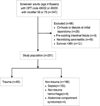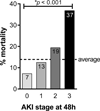Acute Kidney Injury Following Exploratory Laparotomy and Temporary Abdominal Closure
- PMID: 28009772
- PMCID: PMC5468485
- DOI: 10.1097/SHK.0000000000000825
Acute Kidney Injury Following Exploratory Laparotomy and Temporary Abdominal Closure
Abstract
Background: Acute kidney injury (AKI) following exploratory laparotomy and temporary abdominal closure (TAC) is poorly understood but clinically significant. We hypothesized that the prevalence of AKI would be highest 96 h following TAC, early hypoxemia would predict AKI, and that AKI would be an independent predictor of mortality.
Methods: We performed a retrospective analysis of 251 acute care surgery patients managed with TAC by negative pressure wound therapy (NPWT). Kidney Disease: Improving Global Outcomes AKI stages were assessed on admission, initial TAC, and following TAC at 48 h, 96 h, and 7 d. Multivariate regression was performed to identify risk factors for AKI and inpatient mortality.
Results: Fifty-seven percent of all patients developed AKI within 7 days of laparotomy (stage 1: 14%, 2: 21%, 3: 22%). The prevalence of AKI peaked 48 h following TAC, and stage correlated with inpatient mortality (stage 0: 7%, 1: 13%, 2: 19%, 3: 37%, P < 0.001). Overall mortality was 14%. Factors predictive of stage 2 or 3 AKI at 48 h included age >65 years (OR 2.6 [95% CI 1.4-4.9]), NPWT output >30 mL/h from first TAC to 48 h (2.0 [1.1-3.9]), and three parameters at initial laparotomy: mean arterial pressure <60 mm Hg (2.9 [1.0-8.5]), temperature <36°C (2.1 [1.1-3.8]), and anion gap >21 mEq/L (1.9 [1.0-3.7]). AKI was an independent predictor of inpatient mortality (5.5 [2.5-11.8]).
Conclusions: AKI is common following TAC, reaches greatest prevalence 48 h after initial laparotomy, and is associated with increased mortality. NPWT fluid loss is a risk factor for AKI that is unique to TAC patients.
Conflict of interest statement
The authors have no relevant conflicts of interest.
Figures




Similar articles
-
Hypertonic saline resuscitation after emergent laparotomy and temporary abdominal closure.J Trauma Acute Care Surg. 2018 Feb;84(2):350-357. doi: 10.1097/TA.0000000000001730. J Trauma Acute Care Surg. 2018. PMID: 29140948 Free PMC article.
-
Emergent laparotomy and temporary abdominal closure for the cirrhotic patient.J Surg Res. 2017 Apr;210:108-114. doi: 10.1016/j.jss.2016.11.013. Epub 2016 Nov 11. J Surg Res. 2017. PMID: 28457316 Free PMC article.
-
Acute Kidney Injury After Abdominal Surgery: Incidence, Risk Factors, and Outcome.Anesth Analg. 2016 Jun;122(6):1912-20. doi: 10.1213/ANE.0000000000001323. Anesth Analg. 2016. PMID: 27195635
-
Preoperative metabolic acidosis and acute kidney injury after open laparotomy in the neonatal intensive care unit.Pediatr Int. 2019 Oct;61(10):994-1000. doi: 10.1111/ped.13929. Pediatr Int. 2019. PMID: 31267596
-
Characterization of hypoalbuminemia following temporary abdominal closure.J Trauma Acute Care Surg. 2017 Oct;83(4):650-656. doi: 10.1097/TA.0000000000001553. J Trauma Acute Care Surg. 2017. PMID: 28837537 Free PMC article.
Cited by
-
The impact of standardized protocol implementation for surgical damage control and temporary abdominal closure after emergent laparotomy.J Trauma Acute Care Surg. 2019 Apr;86(4):670-678. doi: 10.1097/TA.0000000000002170. J Trauma Acute Care Surg. 2019. PMID: 30562327 Free PMC article.
-
Postoperative Acute Kidney Injury by Age and Sex: A Retrospective Cohort Association Study.Anesthesiology. 2023 Feb 1;138(2):184-194. doi: 10.1097/ALN.0000000000004436. Anesthesiology. 2023. PMID: 36512724 Free PMC article.
-
Hypertonic saline resuscitation after emergent laparotomy and temporary abdominal closure.J Trauma Acute Care Surg. 2018 Feb;84(2):350-357. doi: 10.1097/TA.0000000000001730. J Trauma Acute Care Surg. 2018. PMID: 29140948 Free PMC article.
-
Incidence, risk factors, and outcomes of acute kidney injury in patients undergoing emergency laparotomy - A prospective observational exploratory study.Indian J Anaesth. 2024 Feb;68(2):170-176. doi: 10.4103/ija.ija_675_23. Epub 2024 Jan 29. Indian J Anaesth. 2024. PMID: 38435649 Free PMC article.
-
Obese trauma patients have increased need for dialysis.Eur J Trauma Emerg Surg. 2020 Dec;46(6):1327-1334. doi: 10.1007/s00068-019-01147-9. Epub 2019 May 20. Eur J Trauma Emerg Surg. 2020. PMID: 31111163
References
-
- Rotondo MF, Schwab CW, McGonigal MD, Phillips GR, 3rd, Fruchterman TM, Kauder DR, Latenser BA, Angood PA. 'Damage control': an approach for improved survival in exsanguinating penetrating abdominal injury. J Trauma. 1993;35(3):375–382. discussion 382-3. - PubMed
-
- Diaz JJ, Jr, Cullinane DC, Dutton WD, Jerome R, Bagdonas R, Bilaniuk JW, Collier BR, Como JJ, Cumming J, Griffen M, et al. The management of the open abdomen in trauma and emergency general surgery: part 1-damage control. J Trauma. 2010;68(6):1425–1438. - PubMed
-
- Moore EE, Thomas G. Orr Memorial Lecture. Staged laparotomy for the hypothermia, acidosis, and coagulopathy syndrome. Am J Surg. 1996;172(5):405–410. - PubMed
Publication types
MeSH terms
Grants and funding
LinkOut - more resources
Full Text Sources
Other Literature Sources
Miscellaneous

